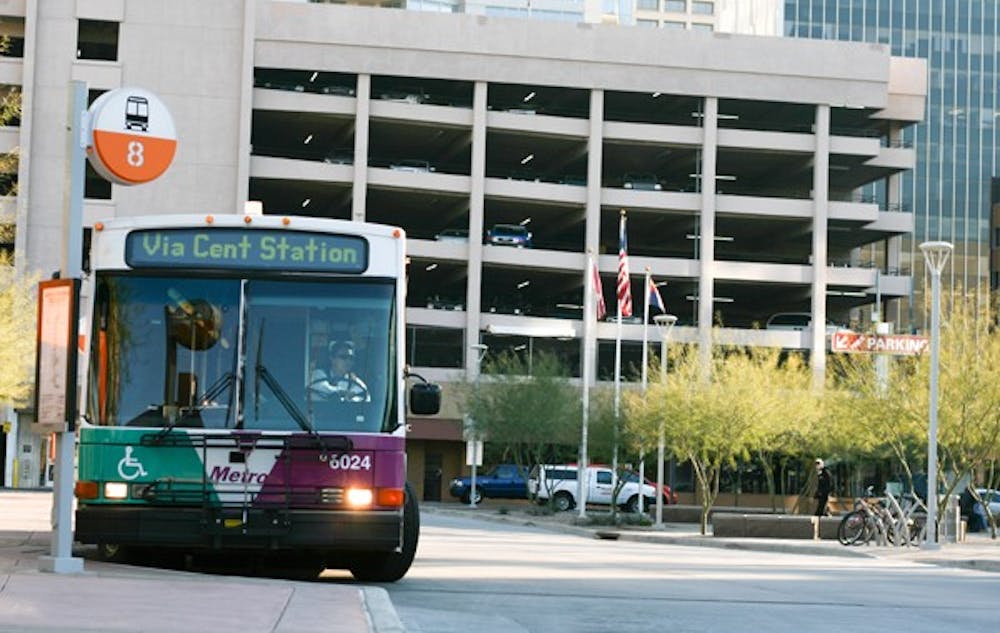 Metro bus Route 8 begins to drive away from the bus stop at the Central Station Transit Center on Tuesday. The Phoenix City Council approved a budget that will be used to purchase 120 buses that will use compressed natural gas. (Photo by Perla Farias)
Metro bus Route 8 begins to drive away from the bus stop at the Central Station Transit Center on Tuesday. The Phoenix City Council approved a budget that will be used to purchase 120 buses that will use compressed natural gas. (Photo by Perla Farias)The Phoenix City Council approved a budget allowing the Department of Public Transit to buy 120 new buses that run on compressed natural gas.
The new buses will cost the city $61 million, and they will arrive between fall 2013 and spring 2014 to replace older buses as they phase out.
Although more sustainable than using petroleum or diesel, the only major difference between LNG and CNG is the method of fuel storage and transportation.
LNG is cryogenically frozen and usually used for larger vehicles such as trucks, said Michael Kuby, professor for the School of Geology, Science and Urban Planning. CNG is stored in the vehicle and is used for smaller vehicles and heavy fleets that have a central yard location for daily fuel, he said.
Kuby said this transition from LNG buses to CNG buses isn't new, because many of the city's buses already run on CNG and the city owns eight CNG service stations.
CNG Services of Arizona owner Dave Clement said because LNG is a frozen liquid, four or five times more fuel can fit into a storage area.
CNG Services of Arizona is a CNG fueling equipment distributor for Arizona and New Mexico.
Although this method produces more fuel, the equipment is more costly and complicated, Clement said.
LNG must be stored in very low-temperature storage units so the gas doesn't vent, while CNG can be stored in vehicle engines and won't evaporate, he said.
Clement said CNG is ideal for local fleets like Phoenix's because the buses work from a central base, where they can fuel on a daily basis.
He said there are more than 400 private CNG stations and eight public CNG stations in Arizona.
Clement said natural gas is a cleaner burning fuel compared to liquid fuels, such as petroleum, which is used by most vehicles because it is a simpler carbon atom.
He said heavier vehicles are making the change to natural gas faster than smaller, personal vehicles, but many car manufacturers have been producing cars that run on natural gas since the '90s.
"We are using natural gas as a bridge fuel to newer technology that will work even better," Clement said.
City of Phoenix spokeswoman Marie Chapple Camacho said though the city will be spending $61 million on these new buses, it will save the city $4 million because each CNG bus is $33,700 cheaper than an LNG bus.
She said CNG can be piped straight to the fleet yard, but the city does not yet have the necessary infrastructure to deliver it in that way.
Camacho said the city will continue using LNG for the existing buses and buy the necessary equipment to compress it into CNG for the new buses.
Arizona has used alternative fuels such as LNG and CNG since the 1990s, she said. Since then, CNG has become the industry standard, she said.
"We have 120 buses to be retired and we asked ourselves, 'How can we make a change?'" Chapple said.
Councilman Michael Nowakowski's aide Caitlyn Mitchell said the city hired a fuel consultant in July to analyze alternative fuel options and develop a long-term fuel strategy for the transit fleet.
The Department of Public Transit presented its recommendations to the Transportation and Infrastructure Subcommittee on Jan. 8 after the study provided evidence that CNG was cleaner and more cost effective.
Councilwoman Thelda Williams and Councilmen Michael Johnson and Daniel Valenzuela all voted in favor of the proposal.
The budget proposal was then sent to the full council where it passed unanimously on Jan. 30.
Reach the reporter at ppineda@asu.edu or follow her @paulinapineda22




